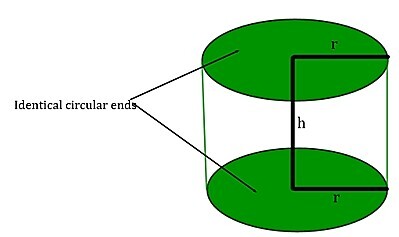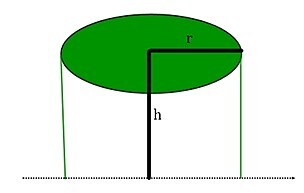
 Data Structure
Data Structure Networking
Networking RDBMS
RDBMS Operating System
Operating System Java
Java MS Excel
MS Excel iOS
iOS HTML
HTML CSS
CSS Android
Android Python
Python C Programming
C Programming C++
C++ C#
C# MongoDB
MongoDB MySQL
MySQL Javascript
Javascript PHP
PHP
- Selected Reading
- UPSC IAS Exams Notes
- Developer's Best Practices
- Questions and Answers
- Effective Resume Writing
- HR Interview Questions
- Computer Glossary
- Who is Who
Right Circular Cylinder
Introduction
A three-dimensional solid figure is called the right circular cylinder. There is a closed circular surface on both ends of the right circular cylinder, which are parallel to one another. The right cylinder is another name for a right circular cylinder. All of the points on the closed surface are equally spaced from the axis of the right circular cylinder. In everyday life, a right circular cylinder is the most typical 3D figure. The correct round cylinder can be created by stacking many circular pieces of paper. It is known as a right circular cylinder because it has been retained at a right angle to the circular base. The surface area, volume, and characteristics of right circular cylinders will all be covered in this tutorial.
Right Circular Cylinders
Right circular cylinders are three-dimensional solid shapes made up of two parallel bases connected by a closed circular surface, with each base resembling a disk-shaped circle. The axis of the right cylinder is the line that connects the centres of two circular bases or runs through their middles. Height, or "?," stands for the perpendicular distance, which is the distance between the cylinder's two bases. The radius of the right circular cylinder, denoted by "?," is the measurement from the centre to the outside boundary for either of the two bases. As a result, two circles and a rectangle combine to create a right circular cylinder. Look at the illustration of the right circular cylinder construction.

Surface Area of Cylinders
The area that the right circular cylinder's surface covers is referred to as the surface area of the right circular cylinder. A right circular cylinder's surface regions can be divided into two categories
Curved surface area of a right circular cylinder:
It is also known as the right circular cylinder's lateral surface area. It is the space between the parallel circular bases of the right circular cylinder, which is covered by the curved surface of the cylinder. Thus, the formula to find the lateral surface area of the right circular cylinder is given by,
$$\mathrm{C.S.A\:=\:2\pi\:rh}$$
Total surface area of a right circular cylinder
It is described as the region that the complete cylinder fills. There are two circles and a curved surface in this region of the cylinder. So, in order to calculate the right circular cylinder's total surface area, we add the areas of the two circles and the curved surface at the end.
$$\mathrm{T.S.A\:=\:2\pi\:rh\:+\:2\pi\:r^{2}\:=\:2\pi\:r(r\:+\:h)}$$
Example
Determine the CSA and TSA of the cylinder whose radius is 1mm and height is 7mm.
Solution
Given ? = 1??, ? = 7??
$\mathrm{C.S.A\:=\:2\pi\:rh\:=\:2\:\times\:\frac{22}{7}\:\times\:1\:\times\:7\:=\:44mm^{2}}$
$\mathrm{T.S.A\:=\:2\pi\:r(r\:+\:h)\:=\:2\:\times\:\frac{22}{7}\:\times\:1\:\times\:(1\:+\:7)\:=\:\frac{44\:\times\:8}{7}\:=\:50.285\:mm^{2}}$
Volume of Cylinders
The area that a right circular cylinder takes up in space is what is meant by the term volume. In terms of cubic units, the right circular cylinder's volume is expressed as $\mathrm{(m^{3},\:cm^{3},\:in^{3}\:or\:ft^{3})}.$
The formula for a right circular cylinder's volume is given as follows for any right circular cylinder with height "?" and radius "?": Height à Area of a Circle Equals Volume of a Cylinder. Hence the formula to find the volume of the right circular cylinder is given by,
$$\mathrm{Volume\:=\:V\:=\:\pi\:r^{2}h}$$
Example
What is the capacity of the cylindrical tank of radius 5cm and height 35 cm?
Solution
The formula to find the volume of the right circular cylinder is given by,
$$\mathrm{Volume\:=\:V\:=\:\pi\:r^{2}h}$$
Given $\mathrm{r\:=\:5cm\:,\:h\:=\:35cm}$
Thus,
$\mathrm{V\:=\:\pi\:r^{2}h\:=\:\frac{22}{7}\:\times\:5\:\times\:5\:\times\:35\:=\:22\:\times\:125\:=\:2750bsol;:cm^{3}}$
Thus, the capacity of the cylindrical tank is 2750 ??3
Solved Examples
1. What is height of cylinder with radius 2 ? and curved surface area 110 ?2 ?
The formula to find the lateral surface area of the right circular cylinder is given by
$$\mathrm{C.S.A\:=\:2\pi\:rh}$$
$$\mathrm{110\:=\:2\:\times\:\frac{22}{7}\:\times\:2\:\times\:h}$$
$$\mathrm{h\:=\:\frac{110\:\times\:7}{4\:\times\:22}\:=\frac{35}{4}\:=\:8.75m}$$
Therefore, the height of the right circular cylinder is 8.75?
2. Determine the volume of the cylindrical flask of diameter 8 ?? and the height is $\mathrm{\frac{7}{2}}$the part of the diameter.
Solution
The formula to find the volume of the right circular cylinder is given by,$\mathrm{Volume\:=\:V\:=\:\pi\:r^{2}h}$
Given $\mathrm{r\:=\:\frac{8}{2}\:=\:4cm\:,\:h\:=\:\frac{7}{2}\:\times\:8cm\:=\:28cm\:V\:=\:\pi\:r^{2}h\:=\:\frac{22}{7}\:\times\:4^{2}\:\times\:28\:=\:22\:\times\:4^{3}\:=\:1408\:cm^{3}}$
Thus, the volume of the cylindrical flask is 1408 ??3
3. What would be the area of the cover sheet required for the cylindrical tent of radius 7 ? and the height 20??
Solution
The cylindrical tent would be as follows

The total surface area of the tent is given by,
$\mathrm{T.S.A\:=\:2\pi\:rh\:+\:\pi\:r^{2}}$
Given, $\mathrm{r\:\:7m,\:h\:=\:20m}$
The total area of the cover sheet required is
$$\mathrm{=\:2\pi\:rh\:+\:\pi\:r^{2}\:=\:\pi\:r(2h\:+\:r)}$$
$$\mathrm{=\:\frac{22}{7}\:\times\:7(40\:+\:7)\:=\:22\:\times\:47\:=\:1034\:m^{3}}$$
Thus, the required area of the cover sheet is 1034 ?2
4. What is the radius of the cylinder whose volume is 200 ??3 and the height is 5 ??. Use ? = 3.14.
Solution
The formula to find the volume of the right circular cylinder is given by $\mathrm{Volume\:=\:V\:=\:\pi\:r^{2}h}$
Given $\mathrm{V\:=\:200cm^{3}\:,\:h\:h\:=\:5cm}$
$$\mathrm{200\:=\:3.14\:\times\:r^{2}\:\times\:5s}$$
$$\mathrm{r^{2}\:=\:\frac{200}{15.7}\:=\:\frac{2000}{157}\:=\:12.74}$$
$$\mathrm{r\:=\:\sqrt{12.74}\:=\:3.57cm}$$
5. Write the formula to calculate the curved surface area, total surface area and volume of the right circular cylinder if its radius is ? units and height is ? units.
solution
$$\mathrm{C.S.A\:=\:2\pi\:rh\:=\:2\pi\:pq}$$
$$\mathrm{T.S.A\:=\:2\pi\:r(r\:+\:h)\:=\:2\pi\:p(P\:+\:q)}$$
$$\mathrm{V\:=\:\pi\:r^{2}h\:=\:\pi\:p^{2}q}$$
Conclusion
The formula to find the lateral surface area of the right circular cylinder is given by $\mathrm{C.S.A\:=\:2\pi\:rh}$
$\mathrm{T.S.A\:=\:2\pi\:rh\:+\:2\pi\:r^{2}(r\:+\:h)}$ is the formula to find the total surface area of the right circular cylinder.
The formula to find the volume of the right circular cylinder is given by $\mathrm{Volume\:=\:V\:=\:\pi\:r^{2}h}$
FAQs
1. What do you name a cylinder's edge?
Cones, spheres, and cylinders lack flat sides, which prevents them from having edges. A vertex is the location where two or more edges come together.
2. Are the bases of a right circular cylinder oval?
Right circular cylinders feature two flat bases, three sides, and one curved side.
3. How many dimensions can there be in a cylinder?
A cylinder, which is derived from the Greek letter o and Romanized as kulindros and means "roller" or "tumbler," has historically been one of the most fundamental curvilinear geometric shapes. It is three dimensional.
4. How many different kinds of cylinders exist?
The two most utilised forms of hydraulic cylinders are single-acting and doubleacting cylinders.
5. Do parallel lines exist on a cylinder?
A cylinder is a 3D solid shape made up of two bases that are parallel and identical and are connected by a curved surface. These bases resemble spherical discs. The axis of the cylinder shape is a line drawn through the centre or connecting the centres of two circular bases.
6. What is the name of the cylinder's curved surface?
Total surface area refers to the curved surface of all sides of a cylinder, excluding the area of the base
7. A cylinder is not a prism, so why not?
A prism is not a geometric figure of revolution, although a cylinder is. While a prism has two plain rectangular faces and two polygons for its two ends, a cylinder has two flat ends and a curved surface. While a prism has several diagonals, a cylinder has none.

